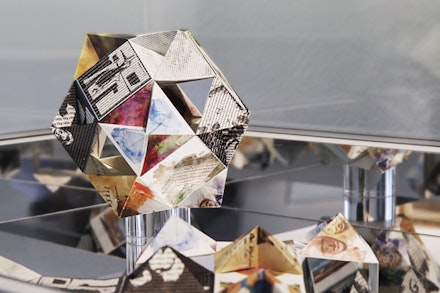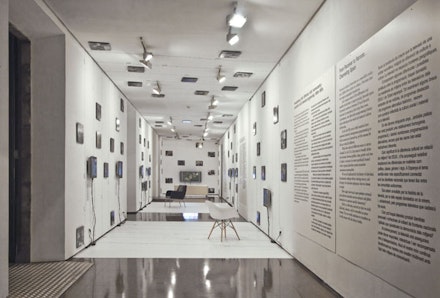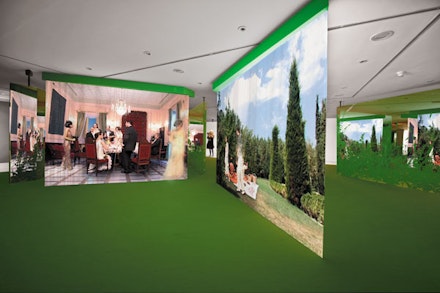JUDITH BARRY is an artist/writer whose work crosses a number of disciplines: performance, installation, film/video, sculpture, architecture, photography, and new media. She has exhibited internationally at Berlin Biennale, several Venice Biennale(s) Art/Architecture, São Paulo Biennale, Sharjah Biennial, Nagoya Biennale, Carnegie International, Whitney Biennale, Sydney Biennale, and dOCUMENTA, among others. Her awards include the Kiesler Prize for Architecture and the Arts, 2000, and a Guggenheim Fellowship, 2011. Currently, she is Professor/Director of the M.F.A. VA Program at Lesley University in Cambridge
The definition of technology (from Greek τέχνη, techne, “art, skill, cunning of hand”; and -λογία, -logia) is the collection of tools, including machinery, modifications, arrangements, and procedures, used by humans. Philosophers as diverse as John Locke, Martin Heidegger, and Gilles Deleuze have discussed technology as a form of world-building, an originary form of truth-revealing, and as a way of destabilizing subjectivity rather than conventionality “as a means to an end.” Meanwhile, the instrumentalization of technology, as Hannah Arendt and Donna Haraway posit in different ways, underscores the danger in the implicit anthropomorphism of technological utopias.

Currently, many media can be iterated to perform digitally and there is a great anxiety or celebration, depending on your viewpoint, that all these disciplines/media—painting, drawing, photo, film, video, sculpture, 2D – 3D forms—will be indistinguishable from one another as they collapse into the digital realm. Yet, these differences and their specificities are still “in there,” and this re-invigorates both the new and old media, no matter the final output. Marshall McLuhan said, “We shape our tools. And then our tools shape us.” Which makes me wonder: if the montage and collage were the image operations that characterized the 20th century, what new forms will the algorithms and computer languages of the 21st century produce? Will they allow for the formlessness required for an endlessly evolving becoming? Or will everything succumb to the logic of the database?
For me the word “tools” connotes many associations. Cooper Hewitt Museum’s definition of tools in the exhibition Tools: Extending our Reach, is as extensions of the human body—a way to allow us to achieve amazing feats by augmenting our abilities. Tools also connote design and craft skills along with the mastery of their use. Are we only as good as our tools, as is often claimed? Identifying the appropriate tools is crucial as my projects are research-driven. The form and content of each project derive from research and analysis. I use the tools I think will best aid the project and my choices differ for each. I do not know what the project will be or how it will look when I begin, and discover this through my analysis. For me tools are anything that aids me in this process, and anything can be a tool—especially research methodologies and “extra-artistic materials” appropriated from other disciplines, and, most importantly, the collaborative generosity of all who contribute to each work. These are my most important tools.
In addition to the above, here are other tools I use in no particular order: architecture, cinema, collage, computing/programming languages, design, drawing, experimentation, imaging devices, montage, networks, new media, serendipity, video, painting, play, the Internet…
To place my “tool” use within a context, I will briefly discuss three works in relation to the tools I employed.
For when all that was read was … so as not to be unknown is a guidebook to the Brain section of dOCUMENTA(13). Carolyn Christov-Bakargiev utilized this section to outline her main themes. My guidebook presented these works as an interactive sculpture, printed as two posters, that the visitor could construct into a guidebook to the exhibition. When assembled, the guidebook presents these works in a non-hierarchical, non-linear array, as an endless space, suspended in time.
I researched C.C.B.’s curatorial method, dOCUMENTA’s histories, artists’ books, and paper technologies, including origami. The posters were developed in watercolor and photography, and further iterated on the computer through experimentation. Videos were provided for ease of assembly, and architecture and design strategies determined the display of the work.
From Receiver to remote control… Channeling Spain 2010
When Ken Saylor and I were asked to recreate the 1990 exhibition, From Receiver To Remote Control, The TV Set for Barcelona in 2010, we proposed updating our research into the television apparatus to compare the differences and similarities across television histories in Spain and the U.S. in relation to “participatory democracy.”

While television is often considered a monolithic entity, it differs from culture to culture. Tele-visual space produces personal and collective identities across national and global boundaries. We were particularly interested in how viewers are constructed as a polis when democratic ideas receive coverage in television media, especially across Spain’s autonomous regions when Franco was deposed. The installation consists of U.S. and Spanish zones, and a collective zone, with television programming specific to both countries in each zone. A timeline comparing television history and democratic movements in Spain and the U.S. corkscrews 360 degrees throughout the installation, inviting participation.
In addition to extensive research into television history and programming, we also explored photo archives to showcase the different ways the television set occupies the home in both countries. The timeline was built in the computer and installed as vinyl, the photos were digitally enhanced to maintain their historical look, including the cut-outs over the flat screens, and the programming was digitized and looped for playback.

Study for the Mirror and Garden uses video and special effects along with architectural mirroring to evoke the secret gardens, hidden meanings, and picaresque narratives of the converso tradition in Spanish literature and culture, which allowed banished cultures to survive by hiding in plain sight. At first the story seems to turn on mistaken identities, but as time ruptures and slips and characters morph into cultural archetypes, it becomes an investigation of the origins of our desire for the irrational to erupt into modern narrative space.
Each time the work is installed, it is designed into the environment such that the viewer is interpolated into the two different narratives unfolding on two translucent screens.
This work required extensive research into the Spanish history and the converso literature, 2D – 3D modeling software, compositing and animation technologies, and architecture and design.